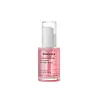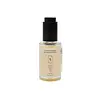What's inside
What's inside
 Key Ingredients
Key Ingredients

 Benefits
Benefits

 Ingredients Side-by-side
Ingredients Side-by-side

Collagen Water
HumectantWater
Skin ConditioningGlycerin
HumectantTripropylene Glycol
AntioxidantNiacinamide
SmoothingTrehalose
HumectantSodium Polyacryloyldimethyl Taurate
Emulsion StabilisingButylene Glycol
HumectantAllantoin
Skin ConditioningPolyglyceryl-10 Laurate
Skin ConditioningSodium Polyacrylate
AbsorbentEthylhexylglycerin
Skin ConditioningHydrolyzed Hyaluronic Acid
HumectantAdenosine
Skin ConditioningXanthan Gum
EmulsifyingPolyquaternium-51
Skin ConditioningDisodium EDTA
Glyceryl Acrylate/Acrylic Acid Copolymer
HumectantCaprylyl Glycol
EmollientPvm/Ma Copolymer
Emulsion StabilisingCyanocobalamin
Skin ConditioningCoptis Japonica Root Extract
Skin ConditioningSodium Hyaluronate
HumectantHydroxypropyltrimonium Hyaluronate
Tocopherol
AntioxidantPropanediol
SolventSaccharide Isomerate
HumectantSodium Acetylated Hyaluronate
HumectantCollagen Extract
Skin ConditioningHyaluronic Acid
HumectantHydrolyzed Sodium Hyaluronate
Skin ConditioningSodium Hyaluronate Crosspolymer
HumectantAlginic Acid
Skin ConditioningSilanetriol
Potassium Hyaluronate
Skin ConditioningHydrolyzed Elastin
EmollientElastin
Skin ConditioningSoluble Elastin
Skin ConditioningTripeptide-1
Skin ConditioningAcetyl Hexapeptide-8
HumectantCopper Tripeptide-1
Skin ConditioningPalmitoyl Tripeptide-5
Skin ConditioningSh-Oligopeptide-1
Skin ConditioningPentapeptide-4
Skin ConditioningPalmitoyl Tripeptide-38
Skin ConditioningHexapeptide-9
Skin ConditioningHexapeptide-12
Skin ConditioningPalmitoyl Pentapeptide-4
Skin ConditioningCollagen Water, Water, Glycerin, Tripropylene Glycol, Niacinamide, Trehalose, Sodium Polyacryloyldimethyl Taurate, Butylene Glycol, Allantoin, Polyglyceryl-10 Laurate, Sodium Polyacrylate, Ethylhexylglycerin, Hydrolyzed Hyaluronic Acid, Adenosine, Xanthan Gum, Polyquaternium-51, Disodium EDTA, Glyceryl Acrylate/Acrylic Acid Copolymer, Caprylyl Glycol, Pvm/Ma Copolymer, Cyanocobalamin, Coptis Japonica Root Extract, Sodium Hyaluronate, Hydroxypropyltrimonium Hyaluronate, Tocopherol, Propanediol, Saccharide Isomerate, Sodium Acetylated Hyaluronate, Collagen Extract, Hyaluronic Acid, Hydrolyzed Sodium Hyaluronate, Sodium Hyaluronate Crosspolymer, Alginic Acid, Silanetriol, Potassium Hyaluronate, Hydrolyzed Elastin, Elastin, Soluble Elastin, Tripeptide-1, Acetyl Hexapeptide-8, Copper Tripeptide-1, Palmitoyl Tripeptide-5, Sh-Oligopeptide-1, Pentapeptide-4, Palmitoyl Tripeptide-38, Hexapeptide-9, Hexapeptide-12, Palmitoyl Pentapeptide-4
Citrus Junos Fruit Water
MaskingGlycine Max Seed Extract
Skin ConditioningWater
Skin ConditioningPhaseolus Radiatus Seed Water
Butylene Glycol
HumectantGlycerin
HumectantPropanediol
SolventIsopentyldiol
Humectant1,2-Hexanediol
Skin ConditioningMethyl Gluceth-20
HumectantBetaine
HumectantDiethoxyethyl Succinate
SolventCamellia Sinensis Leaf Water
MaskingEctoin
Skin ConditioningArtemisia Princeps Leaf Extract
Skin ConditioningCentella Asiatica Leaf Extract
Skin ConditioningLactococcus Ferment
Skin ConditioningCoptis Japonica Root Extract
Skin ConditioningSaccharomyces Ferment Filtrate
HumectantTheobroma Cacao Extract
Skin ConditioningSchisandra Chinensis Fruit Extract
Skin ConditioningHydrolyzed Lupine Protein
Skin ConditioningPalmitoyl Tripeptide-5
Skin ConditioningCaprylyl Glycol
EmollientAcetyl Hexapeptide-8
HumectantPalmitoyl Pentapeptide-4
Skin ConditioningCollagen Extract
Skin ConditioningSodium Hyaluronate
HumectantCarbomer
Emulsion StabilisingDextrin
AbsorbentEthylhexylglycerin
Skin ConditioningTromethamine
BufferingSodium Polyacrylate
AbsorbentCitrus Junos Fruit Water, Glycine Max Seed Extract, Water, Phaseolus Radiatus Seed Water, Butylene Glycol, Glycerin, Propanediol, Isopentyldiol, 1,2-Hexanediol, Methyl Gluceth-20, Betaine, Diethoxyethyl Succinate, Camellia Sinensis Leaf Water, Ectoin, Artemisia Princeps Leaf Extract, Centella Asiatica Leaf Extract, Lactococcus Ferment, Coptis Japonica Root Extract, Saccharomyces Ferment Filtrate, Theobroma Cacao Extract, Schisandra Chinensis Fruit Extract, Hydrolyzed Lupine Protein, Palmitoyl Tripeptide-5, Caprylyl Glycol, Acetyl Hexapeptide-8, Palmitoyl Pentapeptide-4, Collagen Extract, Sodium Hyaluronate, Carbomer, Dextrin, Ethylhexylglycerin, Tromethamine, Sodium Polyacrylate
Ingredients Explained
These ingredients are found in both products.
Ingredients higher up in an ingredient list are typically present in a larger amount.
Acetyl Hexapeptide-8, commonly known as Argireline or Acetyl Hexapeptide-3, is a popular peptide in skincare. It’s often referred to as a “Botox-like” ingredient because it helps reduce muscle movement.
By relaxing these micro-movements, Argireline may help minimize the appearance of fine lines and wrinkles. That said, it’s not as powerful as Botox, and research on its long-term effectiveness is still limited.
Beyond smoothing, Argireline may also support collagen production. Collagen is the protein that helps keep your skin firm, bouncy, and well-hydrated by strengthening the skin barrier.
So while Argireline isn’t a miracle fix, it can be a helpful addition to a routine focused on both prevention and skin health.
Read more about other common types of peptides here:
Learn more about Acetyl Hexapeptide-8Butylene Glycol (or BG) is used within cosmetic products for a few different reasons:
Overall, Butylene Glycol is a safe and well-rounded ingredient that works well with other ingredients.
Though this ingredient works well with most skin types, some people with sensitive skin may experience a reaction such as allergic rashes, closed comedones, or itchiness.
Learn more about Butylene GlycolCaprylyl Glycol is a humectant and emollient, meaning it attracts and preserves moisture.
It is a common ingredient in many products, especially those designed to hydrate skin. The primary benefits are retaining moisture, skin softening, and promoting a healthy skin barrier.
Though Caprylyl Glycol is an alcohol derived from fatty acids, it is not the kind that can dry out skin.
This ingredient is also used as a preservative to extend the life of products. It has slight antimicrobial properties.
Learn more about Caprylyl GlycolCollagen extract is derived from parts of animals. It has skin conditioning properties and is mostly comprised of glycine, proline, and hydroxypoline. These are amino acids.
While our skin does have collagen, this ingredient is not used by the skin for anti-aging. Applying collagen topically has not been linked to helping with collagen loss in skin. All the benefits of collagen are related to hydration.
This ingredient will not increase sun sensitivity, but you should always wear sunscreen during the day.
Learn more about Collagen ExtractCoptis Japonica Root Extract, also known as Japanese Goldthread, is a traditional East Asian herb. It is prized for its anti-inflammatory, antioxidant, and antimicrobial properties.
That’s not all - research in the International Journal of Cosmetic Science found that its active compound, berberine, may help reduce fat accumulation and slow down fat cell development.
This makes it a promising ingredient for slimming and anti-cellulite products!
Learn more about Coptis Japonica Root ExtractEthylhexylglycerin (we can't pronounce this either) is commonly used as a preservative and skin softener. It is derived from glyceryl.
You might see Ethylhexylglycerin often paired with other preservatives such as phenoxyethanol. Ethylhexylglycerin has been found to increase the effectiveness of these other preservatives.
Glycerin is already naturally found in your skin. It helps moisturize and protect your skin.
A study from 2016 found glycerin to be more effective as a humectant than AHAs and hyaluronic acid.
As a humectant, it helps the skin stay hydrated by pulling moisture to your skin. The low molecular weight of glycerin allows it to pull moisture into the deeper layers of your skin.
Hydrated skin improves your skin barrier; Your skin barrier helps protect against irritants and bacteria.
Glycerin has also been found to have antimicrobial and antiviral properties. Due to these properties, glycerin is often used in wound and burn treatments.
In cosmetics, glycerin is usually derived from plants such as soybean or palm. However, it can also be sourced from animals, such as tallow or animal fat.
This ingredient is organic, colorless, odorless, and non-toxic.
Glycerin is the name for this ingredient in American English. British English uses Glycerol/Glycerine.
Learn more about GlycerinYou might know this ingredients as Matrixyl, a famous peptide.
Peptides are building blocks for protein. Palmitoyl Pentapeptide-4 consists of five amino acids. These amino acids include: 2 lysines, 2 threonines, and serine
This ingredients tells our body to create more collagen. Collagen is a protein that makes connective tissue. Boosting collagen production leads to a healthier skin barrier. Having a healthy skin barrier means having firm and hydrated skin.
Thus, Matrixyl may help improve the look of wrinkles.
Read more about other common types of peptides here:
Learn more about Palmitoyl Pentapeptide-4This synthetic peptide is created from lysine, valine, and palmitic acid.
According to the manufacturer, in-vitro studies show tissue growth and collagen synthesis. Another in-vivo study found 60 volunteers saw a significant reduction in wrinkles after 84 days.
Due to its palmitic acid base, this peptide may not be fungal-acne safe.
Learn more about Palmitoyl Tripeptide-5Propanediol is an all-star ingredient. It softens, hydrates, and smooths the skin.
It’s often used to:
Propanediol is not likely to cause sensitivity and considered safe to use. It is derived from corn or petroleum with a clear color and no scent.
Learn more about PropanediolSodium Hyaluronate is hyaluronic acid's salt form. It is commonly derived from the sodium salt of hyaluronic acid.
Like hyaluronic acid, it is great at holding water and acts as a humectant. This makes it a great skin hydrating ingredient.
Sodium Hyaluronate is naturally occurring in our bodies and is mostly found in eye fluid and joints.
These are some other common types of Hyaluronic Acid:
Learn more about Sodium HyaluronateSodium Polyacrylate is the sodium salt of polyacrylic acid. It is used as an absorber, emollient, and stabilizer.
This ingredient is a super-absorbent polymer - meaning it can absorb 100 to 1000 times its mass in water. As an emollient, Sodium Polyacrylate helps soften and soothe skin. Emollients work by creating a barrier to trap moisture in. This helps keep your skin hydrated.
Water. It's the most common cosmetic ingredient of all. You'll usually see it at the top of ingredient lists, meaning that it makes up the largest part of the product.
So why is it so popular? Water most often acts as a solvent - this means that it helps dissolve other ingredients into the formulation.
You'll also recognize water as that liquid we all need to stay alive. If you see this, drink a glass of water. Stay hydrated!
Learn more about Water